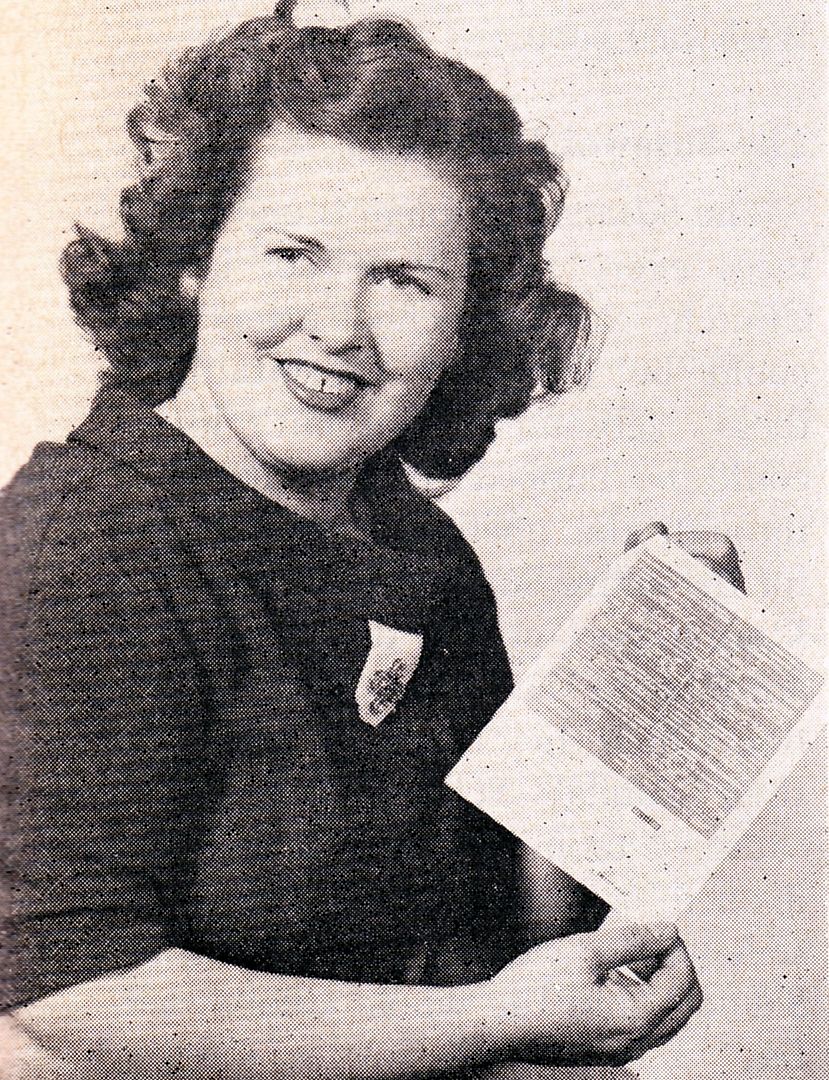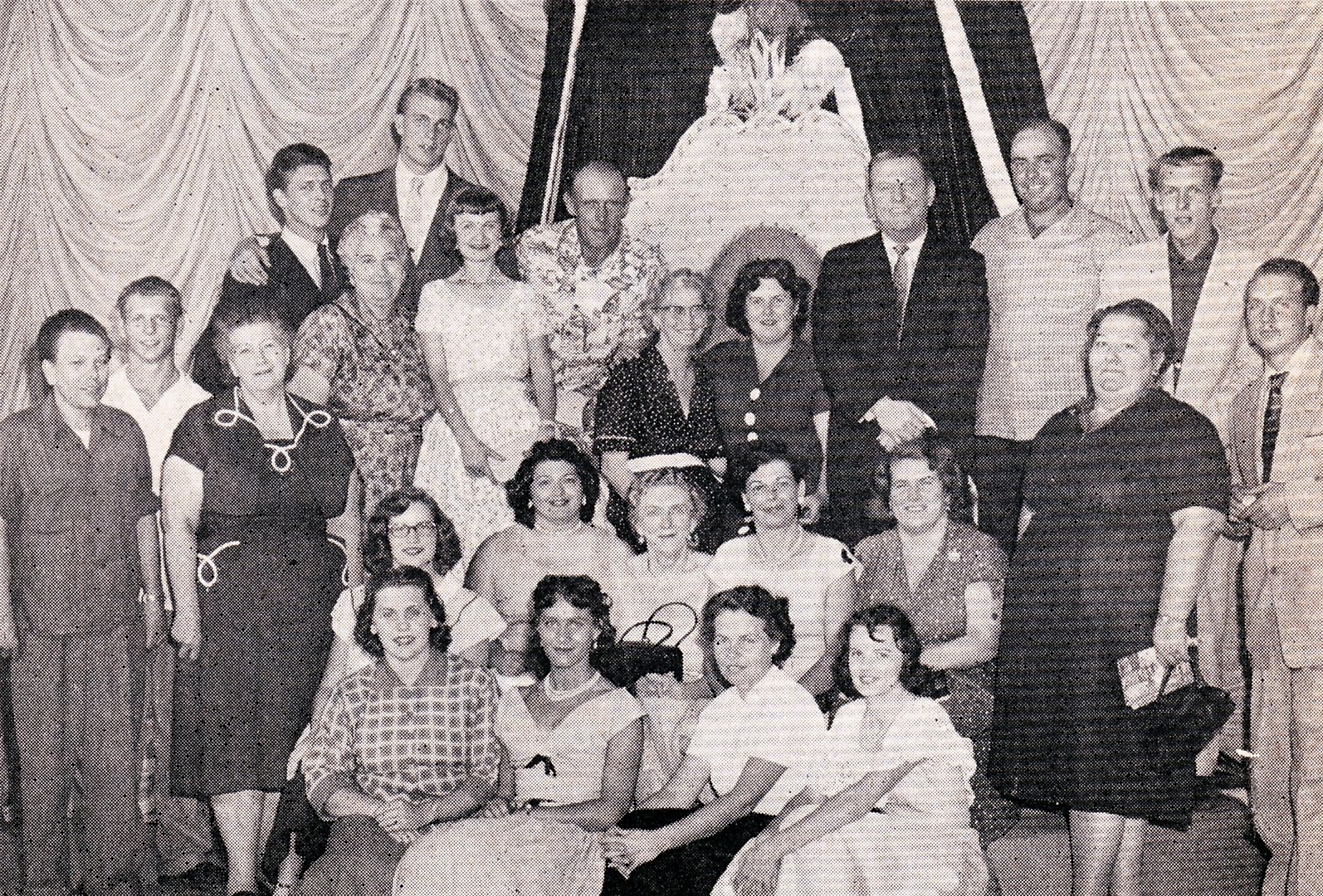Reality TV isn’t an invention of the 1990s – it dates back to the earliest days of television and shows like “Queen for a Day” (broadcast nationally by NBC from 1956 to 1960, after ten years on radio and local television). On that show, host Jack Bailey interviewed contestants, extracting all the tearful details of their unhappy lives, as those contestants explained why a new washing machine or a weekend in Las Vegas would help them cope with unemployed husbands, crippled children, and house fires. The contestant with the most pitiable story, sobbed out in the most engaging manner, was rewarded by the highest score on the audience applause-meter and was crowned Queen for a Day. Seated on a throne, cloaked in satin and fur, with a sparkly crown on her head, the Queen received the item she had asked for, together with a boatload of other “fabulous prizes” donated by the show’s sponsors.
Near the end of July, 1956, a dark-haired young woman from Oklahoma stood in line day after day, hoping for a ticket into the studio and an interview with producers. When she won a spot on the show on Thursday, August 2, and Jack Bailey asked her to tell her story, she looked through the camera and into living rooms all across America.
“I want to know, Who am I?”
-oOo-
In 1927 Bertha Jewett and her baby arrived in Salt Lake City from North Bend, Oregon. Bertha didn’t know anyone in Salt Lake – it was just the next big city on the bus route. Just 21 years old, she had separated from her young husband and needed to find work to support herself. She was unable to care for her baby, Eulah Marie, while she worked, so she asked a new acquaintance – J.M. Jones, or maybe it was J.M. Johnston, or maybe it was something else entirely – and his wife to care for the child. Bertha paid for Eulah Marie’s board and came to see her as often as she could, while she worked long and late to scrape together a living.
One dark day when Bertha went to see Eulah Marie, she found to her horror that the apartment was empty, that the Joneses, or the Johnstons, or whoever they were, had disappeared, taking the baby with them. Bertha went to the police, and eventually J.M. Johnston was indicted for kidnaping.
But it was 1927. There was no Amber Alert or Code Adam, no “America’s Most Wanted” or Center for Missing and Exploited Children. The pictures of missing children were not printed on milk cartons or posted in shopping centers. There wasn’t yet even an F.B.I. charged with solving kidnapings, and there was no interstate law enforcement communication. For an unsophisticated, young, and impoverished single mother like Bertha, there was nothing else to do, nowhere to turn. Her daughter, not quite two years old, had vanished, and soon no one but a heartbroken mother remembered.
-oOo-
In 1943, in Bartlesville, Oklahoma, 18-year-old Eulah Marie Jones was in for a shock. A family friend disclosed to her that she had been a foster child, that the woman who had raised her was not the grandmother that Eulah Marie had always thought she was. Confronting her grandmother and the man she had always known as her father, she was told that when her “parents” had lived in Salt Lake City, Eulah Marie’s mother had “given” her to them. They had eventually come back to their home in Oklahoma, divorcing soon after. Neither had wanted the child they had picked up, so they gave her to her “father’s” mother, who had raised her as a granddaughter. He wasn’t sure of the name of Eulah Marie’s mother and had no idea how to find her. With great difficulty, Eulah Marie tracked down her “foster mother,” but she had little to add; Eulah Marie’s mother wasn’t from Salt Lake, she said, but had come from somewhere else – from somewhere north, she thought. But that was all.
For the next 13 years, Eulah Marie made occasional attempts to find her family by writing to police departments and newspapers in Utah and Idaho, but nothing ever came of her searches. Either her letters weren’t answered, or else the condition of paper records in dusty file rooms was such that no one recognized her story – especially since she was unsure even of the names of her parents. Eulah Marie married, and she and her husband began adopting children – legally.
On July 15, 1955, Eulah Marie was baptized into the Church of Jesus Christ of Latter-day Saints. Her status as a disconnected, unnamed person hit her hard when she filled out the forms for her baptism and was unable to put anything in the spaces reserved for her parents’ names. She was also told that she would be ineligible to go to the temple for her endowment because she could not at the same time be sealed to anyone as her parents. (Whether this was actually Church policy at the time, or whether she was misinformed by a local leader, I do not yet know.) Eulah Marie felt a new urgency to solve the mystery of her origins.
It was a member of her Sunday School genealogy class who first suggested to Eulah Marie that she go on that new television program, “Queen for a Day,” and ask for help finding her parents. Corny as it sounds, that actually was not a bad idea – it was a very popular show, and the class member had stumbled onto the secret of national publicity that we take for granted in solving missing persons cases today.
So in July 1956, Eulah Marie set out on the long drive to California where the show was broadcast, not knowing beforehand what one did to be selected as a contestant or whether she could even be a part of the show’s audience. She stopped in Mesa, Arizona, to visit one of the missionaries who had taught her the gospel, and that missionary arranged for the patriarch of the Maricopa Stake to give Eulah Marie her patriarchal blessing. That blessing said, in part,
Inasmuch as you are seeking your relatives, the Lord will assist you in this matter, and will open up the way for you, that you may be able to receive the necessary information in this regard.
 Eulah Marie traveled on to Hollywood, found the studio from which “Queen for a Day” was broadcast, and every day for a week she stood in line hoping for a ticket. Her persistence finally paid off, and she was admitted to the studio. Along with dozens of other hopeful contestants, she filled out a card explaining why she wanted to appear on the show:
Eulah Marie traveled on to Hollywood, found the studio from which “Queen for a Day” was broadcast, and every day for a week she stood in line hoping for a ticket. Her persistence finally paid off, and she was admitted to the studio. Along with dozens of other hopeful contestants, she filled out a card explaining why she wanted to appear on the show:
What I want most is a birth certificate. My reason is, I want to find my parents. I was told my mother gave me away in Salt Lake City. The couple didn’t stay together very long after they got me. I was left with an elderly lady who raised me. The unusual part of my life is, I’m a foster child, and my children are adopted.
It was enough; she won her appearance on the show, and while she didn’t win the “fabulous prizes” awarded to that day’s Queen, she did have the chance to tell her story and ask for help.
 The studio telephone began to ring as soon as the program ended. One very excited woman said, “My daughter-in-law is your sister, I think; and I know where your mother is!” Another voice came on the line, and a young woman told her that her mother had had a little girl kidnaped when the baby was just two years old – her name had been Eulah Marie Jewett, and she had the same birthday as Eulah Marie Jones.
The studio telephone began to ring as soon as the program ended. One very excited woman said, “My daughter-in-law is your sister, I think; and I know where your mother is!” Another voice came on the line, and a young woman told her that her mother had had a little girl kidnaped when the baby was just two years old – her name had been Eulah Marie Jewett, and she had the same birthday as Eulah Marie Jones.
Soon after, Eulah Marie received separate calls from an uncle and an aunt, and a cousin, all of whom confirmed the story of Eulah Marie’s kidnaping and telling her how and where to find her mother … and her seven younger brothers and sisters, born after her mother’s remarriage a few years after Eulah Marie’s disappearance.
 Eulah Marie very quickly had her reunion with her family – and was surprised, and delighted, to learn that except for one of her siblings, her entire family had joined the church just as she had. Eulah Marie and her family were invited back to the set of “Queen for a Day,” where Eulah Marie sat on the queen’s throne, surrounded by her new-found family, as the show’s master of ceremonies presented her with a copy of her Oregon birth certificate.
Eulah Marie very quickly had her reunion with her family – and was surprised, and delighted, to learn that except for one of her siblings, her entire family had joined the church just as she had. Eulah Marie and her family were invited back to the set of “Queen for a Day,” where Eulah Marie sat on the queen’s throne, surrounded by her new-found family, as the show’s master of ceremonies presented her with a copy of her Oregon birth certificate.
Mother and daughter maintained their relationship until Bertha died in 1965. Eulah Marie passed away in 1982. J.M. Jones — or Johnston — was never prosecuted for kidnaping.
Continue reading at the original source →



